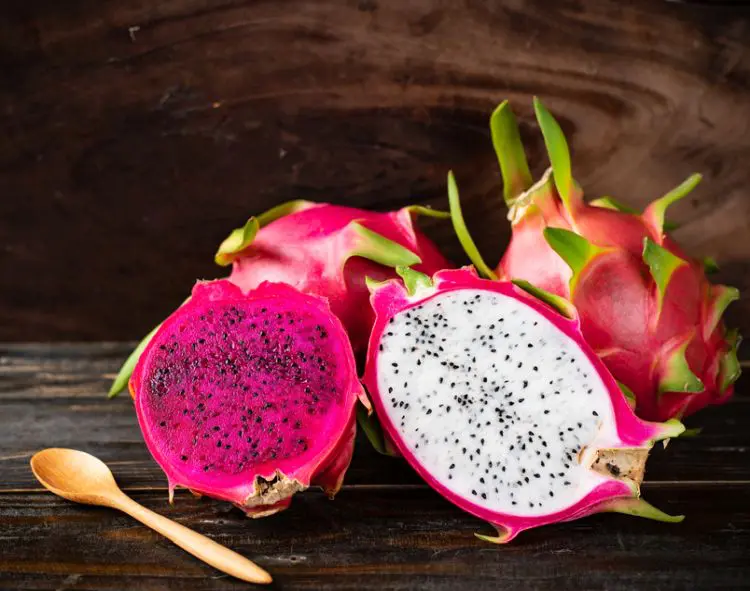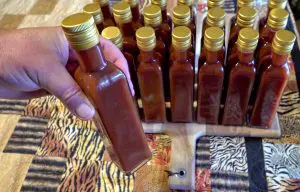Meet dragon fruit- a truly wonderful, delicious and exotic-looking tropical fruit that is easy to grow at home. With the texture of kiwifruit and the taste of lemonade, dragon fruit is a delightful addition to drinks and desserts (like our dragon fruit & finger lime sorbet), and of course, is fantastic eaten on its own.

Dragon fruit, (selenicereus sp) also called pitaya, is native to southern Mexico and coastal areas of Guatemala, Costa Rica, and El Salvador. It is currently cultivated as a commercial crop throughout south-east Asia, and tropical & subtropical regions of the United States, the Caribbean and Australia.
Nutritionally, dragon fruit is a great fruit choice, as it is low in calories and high in nutrients & antioxidants. It contains vitamins C and E plus iron, magnesium and beneficial plant compounds such as polyphenols, carotenoids and betacyanins. It is high in fibre, including those valuable prebiotics which promote gut health.
Plant Selection & Varieties

There are over 50 varieties of dragon fruit, with the flesh ranging in colour from white to orange to pale pink to deep purple. Skins may be yellow, orange, pink, red or purple, with some yellow varieties having thorns.


The most common question I am asked by people attempting to grow dragon fruit is ‘why isn’t my plant fruiting?’. There could be a number of reasons for this, but the main issue is the type of plant thats growing.
Buy a cutting, rather than seed or a seedling. Cuttings grow and fruit faster than plants grown from seed. You *can* grow dragon fruit from seed, but why bother when cutting-grown plants can fruit within a year, versus 6-8 years when grown from seed.
Buy a variety which fruits easily. Self-sterile varieties of dragon fruit require hand pollination in order to set fruit, whereas self fertile varieties don’t. When starting out, I recommend you choose a self-fertile variety. This is because hand pollination can be fickle- it’s a fiddly job which requires precise timing and technique. Dragon fruit flower at night, and for one night only. On top of that, you need to be growing both a self-sterile and a self-fertile type, and have them both flowering on the same night. Then you go out and hand-pollinate by torchlight. See what I mean?

Personally, I have found there is a direct link between ants and successful fruit set in self-pollinating varieties. In other words, the more ants around, the better your chances of having your flowers fertilised. So if you notice ants running up and down your dragon fruit plants, I suggest leaving them alone.
Planting & Propagating
Dragon fruit can be planted year-round except in frosty winter conditions. Generally, dragon fruit is long lived, and as a cactus its significant energy reserves allow it to self-establish easily.


When growing via cutting, firstly choose a healthy-looking specimen at least 30 cm long. Leave it out to dry for a week or two. Soil pathogens & other diseases can easily enter the cutting via the fresh cut, so this helps prevent rotting and infection. After drying, place the cutting into a pot of quality potting mix and water it in. Keep the pot in a cool shaded area until it strikes. Water lightly once a week, but take care not to over-water as cuttings can rot and die quite easily. Cuttings will take root in 4-6 weeks and can then be planted out in a sunny location.


The most important thing to know about planting dragon fruit is that it will need a strong support structure that allows the branches to grow upwards then cascade down. While there are a few different ways to go about this, successful growers usually use a central post with either a round or square section at the top for the branches to grow through then hang over. These sorts of trellises, shown above, can be made from metal or timber, and work whether your dragon fruit is in the ground or in a pot.
Plant 2-4 cuttings per post, depending on the post diameter. Train the cuttings by tying them to the post or trellis. Only allow 2-3 shoots from each plant to grow to the top of the trellis – prune the rest off.
Position & Climate
Despite being a type of cactus, dragon fruit is not suited to the desert conditions that cactus typically like. On the contrary, they are a tropical plant that likes plenty of rainfall. While they will grow in full sun, dragon fruit grown in the tropics & subtropics do like some protection from summers harsh afternoon sun, and in these climates they seem to grow better in a semi-shade position.
If you live in a climate which is cooler than ideal for dragon fruit, then a full sun position may be better (ideal is USA zones 10-11). Dragon fruit thrives in the 20-30C (70-85F) temperature range with at least 6 hours of full sun per day. It can withstand temperatures either side of this, including the odd light frost, but you should take care to position your dragon fruit plant so that its as close as possible to its ideal temperature range.

Containers, Soil & Fertiliser
Dragon fruit vines will grow well in containers, as long as they have enough room. While they will survive in small pots, a pot of at least 40cm (15″) diameter is best because this gives the plant enough room for healthy growth and decent fruiting. Additionally, dragon fruit grows to be a huge, heavy & fragile plant which is difficult to transplant once mature.
As a cactus, dragon fruit needs a light yet rich soil which drains fully as wet feet will rot the base of the plant. Therefore, the growing medium should be really free-draining; a combination of potting mix & cactus mix or potting mix & perlite is ideal. Prepare your soil before planting. Add some aged chicken manure or chicken manure pellets into your growing medium, and include plenty or organic material. Mulch the soil once planted. After your dragon fruit plant is established, they should only require fertilising once or twice a year, at the start of spring and during the summer growing season. Top dress with compost and potash to encourage fruiting.
Water
Just because dragon fruit is a cactus and *can* handle periods of drought, doesn’t mean that it *should*. Dragon fruit will grow better and produce more fruit if watered regularly. As an example, here in subtropical south-east Queensland, I water my dragon fruit twice a week in summer and once a week in winter (when it is dormant).
As with every fruiting plant, regularity of watering during the growth season is very important. Dragon fruit grows extremely fast during summer, and regular water will encourage branching, flowering and fruit set. At the same time, be careful not to water too often: as a guide, the top 1-2 inches of soil should be dry at the time of watering.
Pests & Diseases

Dragon fruit is a hardy plant which generally suffers little damage from either pests or diseases.
Large pests may try to eat the fruit as it is ripening, but the spiky branches are usually enough to deter them.
QLD fruit fly doesn’t sting dragon fruit, so there should be no need to net the fruit.
Fungal problems can sometimes arise during summer when the humidity is high. Rust spots which develop into rot may appear; however, my plants seem to get over it without any intervention. If a plant looks like it is in trouble from a fungal attack, I recommend sparingly using a fungicide (as directed).
In 2014 I had my first serious fungal attack on a (red) dragon fruit vine, which caused severe dieback. The rust spots appeared randomly, then rapidly spread. I used a fungal spray as treatment then removed the affected branches. Should your dragon fruit plant become sunburned, a dose of epsom salts (dilute according to instructions on the packet) watered into the base of the plant may help it recover.
Pruning
Dragon fruit plants respond very well to pruning, which should be done after it has finished fruiting. This timing is for two reasons. Firstly, so that you don’t accidentally remove any soon-to-be buds which are to become fruit. Secondly, pruning at this time ensures the plant goes into its energy-building dormant phase in a healthy condition. Always use clean, sharp secateurs, and prune at the base of each section.
Pruning keeps the plant healthy by getting rid of any dead or diseased branches plus encourages fresh new growth. Shape the plant where possible so as to spread the branches evenly. Remove any dead, messy or ‘crossed-over’ branches, plus any new shoots from the lower stems. This will maximise air flow and limit disease.


Tipping is a kind of pruning which is done to encourage fruiting. It’s super-simple; all you need to do is cut about 2″ off the ends of the branches. This ‘tricks’ the plant into fruiting by stressing it just enough that it goes into survival mode, and sets a whole lot of fruit.
Fruiting & Flowering
It is commonly said that a dragon fruit plant should start producing fruit in approximately 12-18 months. Personally, I have found that growth rather than age is a better indicator of fruiting potential.
I have learned that a dragon fruit plant will start to flower and fruit after its branches have reached the maximum height their trellis provides for and have started trailing downwards. This happens because once each single stem grows upwards up and falls down under its own weight, it triggers small fractures in the stem wall, which in turn stimulates branching and then flowering.



Dragon fruit usually flower during summer, very close to the longest day of the year. Depending on your climate, you may see sporadic flowing during the cooler seasons too. This plant produces one single large flower per fruit, and although short-lived, its (usually) nocturnal show is truly a sight to behold. The spectacular flowers have a diameter of 8″ or more, but you need to know when they’re coming, as they open for just a few hours. The flowers are pollinated by ants, bats and moths.
Harvesting & Storing
Dragon fruit do not ripen any further once picked. You need to make sure the fruit is fully ripe before picking it, which can be a little tricky with this particular fruit. Visually inspect the fruit to see that the colour is vibrant and fully red (or pink or yellow or purple). The skin should feel slightly soft (like a silicone-filled ball) when lightly squeezed or poked.
To remove the fruit simply rotate it & pull gently, and it should come away rather easily – if it doesn’t come off easily it probably isn’t fully ripe.

If you’re growing a thorny variety, its thorns need to be removed before harvesting as they can be razor-sharp. This can be done by using an implement such as pliers or a brush. If the fruit is ripe, the thorns should already be showing signs of shedding so will easily rub off.
Dragonfruit freezes beautifully if you can’t eat it all at once. Simply peel it, chop it as you like, and put it in an airtight bag or container. If storing in the fridge, wrap whole dragon fruit in a paper towel and place in the vegetable crisper. It will keep for up to 2 weeks this way.
To get more juice on dragon fruit, check out our youtube channel- we love dragon fruit so much, there’s a ton of videos for you to watch!













